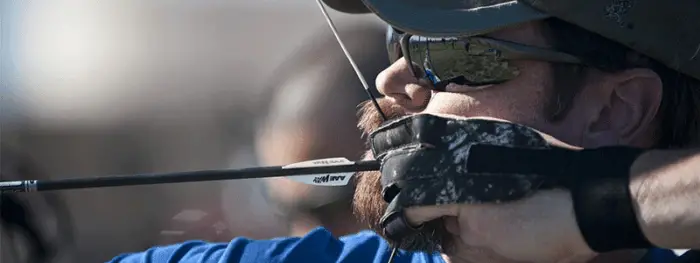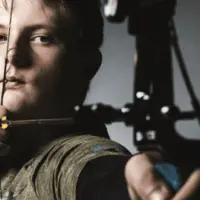Bowhunting, 3D archery and field archery all have something in common – in most cases the distance to the target is unmarked. This introduces a whole new challenge to shooting your bow. A wrong assessment can mean the difference between hitting the target exactly where you aim to and missing the target completely. In this article we’re going to discuss yardage judging, so you can quickly train to be an expert.
The skill of being able to precisely estimate the distance to your target is really important. Especially if you want to get involved in 3D archery, field archery or bowhunting. As I’ve covered in my post about archery tournaments, most field archery 3D archery competitions have unmarked targets and don’t allow rangefinders usage. So how do expert 3D archers learn to judge yardage?
There are a few methods that take advantage of perspective to estimate the distance to the target. Most archers split the distance to the target into smaller chunks, and estimate the distance between each one. In the end, learning yardage judging comes to training your gut feel, so you can eventually assess the distance to the target just by looking at it.
In this short guide, we’re first going to discuss beginner yardage judging methods – these can work as some sort of a crutch, only to be temporarily used until you develop a true sense of distance judging. After that we’re going to cover the best ways to train your gut feel, so you can practice like an expert. You’ll even be able to estimate the length of this article. Well, that’s probably a bit different… but let’s go!
Practice your gut feel
Highly experienced archers can simply look at a target, and know exactly how far away it is. This kind of sixth sense is what every archer should aim (wink wink) to develop.
Basically, after years of shooting from any distance to various targets, at different environments, you can learn to trust your gut and accurately judge the distance. This ability is not based on tricks and methods – it’s just pure skill. You can work to develop this skill as a part of your bowhunting skillset.
As a beginner archer, you should aim to work on your distance judging skills while learning to use the bow. Many beginner archers who fail to do that have a really hard time developing this skill later on, since it requires a lot of time.
The simplest way to start practicing your yardage judging is simply by positioning yourself in various unknown distances in the range, guessing the distance to the target and checking how far off you were. After checking the actual distance – take the shot. You can use a cheap rangefinder to start off at a fair price. I actually recommended my top rangefinder picks in another post. Practicing this way will help you improve significantly over time.
Try to constantly mix things up; use different targets (different face sizes, 3D targets, etc) and different positioning. Try to find locations to practice uphill and downhill yardage judging, and practice at different angles and environments.
Here’s a short video I really liked that explains both the idea of practicing your gut feel, and the distance splitting method that I’m going to detail in the next section.
You can learn to estimate yardage and develop this gut feel by practicing it often. It all comes down to experience. A good way to start is to place objects to mark distances in your range. If for example, you followed my guide for building your own backyard archery range, we’ve listed distance markers as an essential part of your range.
Even if you practice at a standard range, if they don’t have a distance marker, you can set up your own using a simple rangefinder and some pegs. Constantly seeing marked distances will help with your distance judging by becoming used to splitting the distance into smaller increments. And this leads us to the way most archers learn and practice their yardage judging…
The distance splitting method
Distance splitting is the way most archers learn to judge yardage. Once you master it, practicing 3D shoots will become much easier. By improving your distance splitting skills you will learn to judge distances better and better until it becomes completely seamless.
Distance splitting basically means you find a nearby object you have a gut feel of its distance. Later you find another object and judge the distance between them until you reach the target. Practicing distance splitting will enable you to judge yardage to faraway targets without having to make definite hard calls.
It’s a great method because even beginner archers can judge yardage within 10 yards after a few practice sessions. It basically means you can judge the distance of far targets, even with limited skills.
It’s also a good way to develop your gut feel. At first, you will only be able to get a gut feel for nearby targets, which means you will have to split the distance a lot of times. As you progress, you will get a gut feel for further and further objects and will make fewer splits. You constantly train your skillset this way and learn to trust yourself.
Some archers take this method to the next level, by using the distance splitting multiple times and comparing their results. So, they begin by making an initial guess of the target distance. They later make a few different distance splits and see if the results are somewhat close. By averaging the distances they can get a more accurate estimation.
You should aim to master yardage judging to 20 yards. Every split you make adds a small error to your final distance estimation. These errors quickly add up if you make a lot of splits. This means that by practicing and being able to make fewer splits you become more and more accurate. Mastering distance judging within 20 yards will enable you to make good decisions in most archery situations. As a beginner, you should make this a priority.
If you want to practice your distance splitting skills, the simplest way is to shoot on unmarked ranges frequently and put your focus into it. You can make things more interesting by involving your friends and playing the “unknown range game” I’ve covered in my archery practice games post. Either way, by practicing distance splitting a lot you’ll be able to quickly achieve the goal of master 20-yard distance judging.
Target framing- beginners method
This method mainly works for standard targets. Simply put, in the target sizing method you compare the size of your sight and the size of the target to guess the distance. The main downsides of this method are that it’s slow, it requires you to draw consistently and to know the size of the target beforehand. The pro of this method is that it’s really easy to learn and quickly start using – basically within a single practice session.
To set up the 50% system, place yourself in front of the target, in a known distance. For a face size of 80cm, you’ll need to stand 40 meters away, for a 60cm you’ll stand 30 meters away, etc. Draw your bow, and place your sight to cover 50% of the target. Remember this position.
Now count the number of rings on the target. In an unknown distance, every ring your sight blocks are translated to the original distance, divided by the number of rings. So in an unknown distance, draw your bow to the same position and count how many rings it blocks.
So for example, if you originally stood 30 meters away from a 60cm target with 5 rings, every ring your sight covers is worth 6 meters (30 meters, divided by 5). If you stand in an unknown distance, and your sight covers 8 rings, it means you are standing 48 meters away from the target.
This method might be limited, but it’s a good way to start and get the feel of distance judging. If you plan on seriously practice archery, you shouldn’t count on it for a long while.
Conclusions
Yardage judging is an important skill, that quickly comes to play for any field or 3D archer. It takes time to master it, be with practice you will be able to develop an incredible gut feel. While you’re learning, you should aim to use distance splitting and start judging distances right away. It all comes down to practice and patience.



